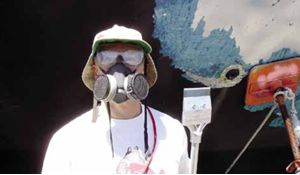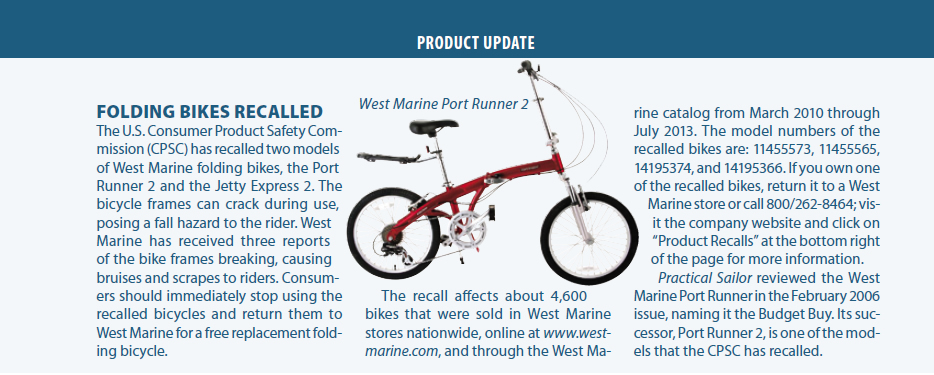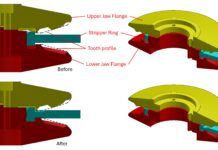Photo courtesy of Mark Hoenke

In response to your recent blog on removing bottom paint: We totally stripped our 1984 Camper Nicholson 58 in two days. Without a doubt, the best tool in our kit for stripping many layers of bottom paint was a massive linoleum floor scraper. It has one straight blade and one slightly curved. I used the belt sander with 800-grit sandpaper to keep it razor sharp. Sharpening was needed every 5 square feet.
I find sanders way too messy for this, and many paints instantly plug the grit. Paint came off in small rafts and sheets that were easily collected on tarps with little airborne dust.
Mark and Lynn Hoenke
Roxy, Camper Nicholson 58 Ketch
Muskegon, Mich.
A short word of caution: Be very careful when using the linoleum scrapers straight blade to remove bottom paint. Because its edges are not rounded, they are more likely to gouge gelcoat or damage an epoxy barrier layer.
My wife and I are getting our 45-foot ketch ready to go cruising. The teak deck needs to be sanded and put a coating on the teak. What would you suggest for longevity? As far as maintenance, I don’t care if I have to apply a coat every couple of years, but I am looking for longevity and easy upkeep.
Harry Armstrong
Via www.practical-sailor.com
In our opinion, you should leave teak decks bare. If they are looking shabby, clean them with detergent, or advance to a teak cleaner (PS, May 2010 and June 2010) for badly weathered decks, and sand only if you absolutely must.
Unfinished teak offers the best nonskid traction-better than most nonskid paints and mats-but if youre set on coating the deck, we would only use Semco Teak Sealer in Natural (www.semcoteakproducts.com). It was Recommended in our most recent series of exterior wood finish tests (PS, September 2011, December 2009, May 2009, October 2007). Its a soft finish, so you will need to recoat three to four times per year. Any hard coating that would last longer would be too slippery for a deck.
In response to your bottom-paint stripping blog: I have stripped my bottom twice. I used just a pull scraper and a random-orbital sander. The scraper takes off the loosely adhering stuff, and the machine does the rest. Buy plenty of sandpaper, and don’t wait too long to change discs.
You can’t go too cheap with the sander, but my $50 Porter Cable seems good enough. It allows the attachment of a vacuum hose and has holes in the disk to suck away the dust.
I also experimented with a chemical stripper. It required less physical labor, but the downside is that washing the stuff off makes a huge mess that is difficult to contain and wont earn you any points with the yard manager. Scraping the softened paint off combines the worst of both methods. Also, the yard asks that I use a HEPA filter on the vacuum, which is pretty expensive. I found a particle separator that saves the filter: Dust Deputy from Oneida Air Systems.
Barry Needalman
I have switched all my many magazines, books, and newspapers to my iPad, and would love to be able to keep my Practical Sailor issues digitally-to be able to keep it as a database for future reference instead of paper and to carry it with me at all time, on and off the boat. Is this possible and is there an app in the works?
Eric L. Sass
Maineiak, C&C 40 AC
Sedgwick, Maine
If youre a subscriber, you can download a digital version of each issue in PDF format, and you can store it anywhere you like so you can access it even when there is no WiFi service. To download the current issue, simply go to www.practical-sailor.com, click on the link for the current issue on the right side of the homepage, then select Download this Issue, and youll get the full-issue PDF. You can also visit the Issue Archive on the website (the link is under Resources on the right side of the webpages), and click on any back issue to download it.
The March 2014 issue contained tips for a do-it-yourself anemometer installation that provided excellent advice. Here are a few more hints.
Replacement installs: 1) Take a radio up the mast with you to afford two-way communication with deck crew. My mast is 75 feet off the water, so radios are essential, especially if winds are not calm. 2) Also, take an impact driver, with an assortment of tips, and a hammer up to remove recalcitrant fasteners. 3) Broken screws may need filing to get them flush.
4) Retain any wiring to use as messenger lines to pull new wires up/down the mast. 5) Make a stiff paper template to accurately show the mounting space available. 6) Send the template down, along with the old unit, so the deck crew can mark the template with new fastener locations. 7) Using a sharp punch, transfer the new fastener locations to the truck, use a small center drill to provide positive drill bit locations, then drill the appropriate diameter holes, and tap as necessary. Use some cream hand cleaner to trap chips and facilitate drilling and tapping procedures.
New Installation: 1) Use the above tips, but have the deck crew make a template showing the location of the new fasteners, then follow the last two hints above. 2) Some trimming of the template edges may be required, but be sure the new anemometer is well ahead of the mast and in clear air.
Dr. Charles F. Barth
Crazy Horse, C&C 37 TR
Lorain, Ohio
In a recent email from Practical Sailor, there was mention of Nigel Calders great Cruising Handbook, wherein you quoted his advice on installing conduit in masts, paraphrased here: Lay the mast down, put a generous bead of silicone or polyurethane adhesive on one side of the conduit, slide the conduit in with the adhesive facing away from the mast wall, then roll the conduit so the adhesive is between the mast wall and conduit, gluing it in place. Then drill any needed exit holes in the conduit (and mast if needed) and fish cables through.
I have a suggested improvement, which is particularly important for plastic conduit or if the exit holes are not all aligned. Plastic conduit is rarely perfectly straight, so Calders method may present difficulties in aligning the conduit within the mast. Make sure all holes are drilled through the mast before inserting the conduit, then insert a loop of wire or heavy monofilament line in each hole so that the conduit passes through the loops. After inserting the conduit, squeeze a good-sized blob of adhesive through each hole and pull each loop tight to pull the conduit tight to each hole, and let the adhesive dry before drilling the conduit. Ream the holes smooth and then pull the cables.
Rusty Gesner
On a Whim, Macgregor 26S
Portland, Ore
We, the Recreational Boaters of California organization (www.rboc.org), would like to enhance some of the points made in the editorial in the March 2014 issue. It is correct to state that the Southern California water boards say they have no choice but to take action to reduce the amount of copper in the water because the level of copper exceeds the federal standard. Certain California harbors are cited as having a copper problem, and recreational boats are identified as being one source.
Well, every single California marina where recreational boats are kept shows levels of copper that exceed the federal standard. However, the editorial then makes the implicit assumption that the copper is present at toxic levels. That is not the case.
Sixteen years ago, South San Francisco Bay was targeted by the Regional Water Board for action relating to levels of copper in the water column that exceeded the federal standard. At that time, the cities, utilities, and industries in the area, which had also been identified as dischargers of copper, formed a collaborative association with the water board to determine whether the high copper levels were actually impairing bay waters. The EPA, which set the federal standard as maximally protective, recommends this approach for establishing site-specific standards. The outcome of this lengthy and expensive effort was to determine that while the level of copper was elevated, it was not toxic. As a result, in 2007, the regional board adopted Resolution R2-2007-0042 to adopt site-specific objectives for copper. The final report recommended removing the bay from the list of impaired water bodies for copper, and this has been done. The report is online here: www.cuactionplan.org/files/Cu%20Impairment%20Assessment.pdf.
So, now, we have an anomalous situation: There are no copper-impaired water bodies in San Francisco Bay, but every other water body in the state with similar levels of copper is listed as impaired. Not unexpectedly, boaters in Marina Del Rey and elsewhere in Southern California are upset that the water boards in their region did not follow the precedent set in San Francisco. Particularly so since the EPA is due to promulgate a model for assessing copper toxicity that is far less costly.
Moreover, the federal standard is extremely low. Not very much higher than the background level for copper in the open ocean. As a consequence, it is unlikely that the amount of copper in the water column can ever meet the standard, even if every boat left the marina or converted to a non-copper coating. Individual boaters are identified as being dischargers, and if enforcement actions are taken, could be subject to serious penalties under the Clean Water Act.
So yes, California boaters should take a close look at the value of hull cleaning and should become educated on antifouling issues, but they are not poisoning the critters in the water beneath their hulls. And they should not be threatened with penalties for using state-approved antifouling paints.
Karen Rhyne, President
Recreational Boaters of California
There is an error in my previous proposal for estimating the amount of energy that a snubber system will absorb as it stretches (PS Mailport, January 2014). I mistakenly multiplied the force by the total displaced length at each inch of displacement. Sorry for the misdirection.
Neal Parker
Navigator, Krogen 48
Seattle, Wash.
We agree that the energy absorbing characteristics of the chain in a snubber/chain rode should not be ignored (PS Mailport, January 2014). However, we were trying to emphasize the elasticity of the snubber as our observations are that snubbers are simply not used frequently, and usually are too short and too large in diameter to utilize their energy-absorbing characteristics.
Many who buy modern anchors always comment that when they set their anchors on all-chain rodes, the suddenness of deceleration when the anchor bites as the vessel drifts back on the wind is sufficient to knock over the unwary. Catenary never disappears, and even under benign conditions with some sag in the chain, the suddenness of the stop is sharp-basically, the chain impacts as if the vessel has hit a brick wall (or a very unforgiving rock on the seabed).
Try the same experiment with the snubber attached, and it is possible to both stand upright and do so holding a generous glass of your favorite chilled beverage. Basically, the nylon snubber absorbs the kinetic energy of the moving boat better than does the catenary.
We intend to compare the effects of combining a nylon rode with a chain rode to only nylon and only chain. We also want to look at different brands of anchor plait, as we think there might be significant differences in performance.
I purchased a Chelsea Shipstrike Quartz clock four years ago from West Marine for about $600. There were less expensive options, but Chelsea is an american company, and I try to buy American at every opportunity.
I changed batteries this spring, and the clock stopped working. Chelsea informed me that it could not be repaired and that the mechanism needed replacement; cost, $228. I was told that there were no craftsmen to repair the clocks because the works for this American-made clock were made in Germany.
I delivered the clock in person to Chelsea.They gave me the same story on repairs, and advised that the repair time would be six to eight weeks. The estimate was $250, plus $190 to polish the pitted case. I reiterated my disappointment at the unreasonable cost. The young lady was quite nice and said she would forward my concerns to her supervisor. The supervisor sent me a letter offering a 15-percent discount; I accepted but said that I intended to let everyone I know about my experience. I received a subsequent letter that they would replace the works at their cost of $100.
Why did I have to go through that much of a hassle to have them do what they should have done immediately? Surely a clock of that quality should be reliable for more than four years, and the company should stand behind it.
John Coelho
Voyager II, Whitby 42
Cruising the East Coast & Bahamas
We contacted Chelsea Clocks director of sales and customer service Lisa Polidoro about your experience. In an email, Polidoro responded that Chelsea stands behind its products and services, and works very hard to make sure customers are completely satisfied. She added that Chelsea manufactures thousands of clocks, barometers, and tide instruments annually and that their return rate is less than 1 percent. She went on to explain that the company privacy policy prevents her discussing customer transactions and payment details with third parties (like Practical Sailor). Wed like to hear from any other readers who have had dealings with Chelsea customer service (good and bad).
Photo courtesy of Mark Hoenke

I read with interest the Mailport letter (PS, April 2014) about combatting onboard toilet odors with a homemade solution of Calgon, water, and detergent, but what is HD non-sudsing detergent, what brands are available, and where can they be purchased?
Every one of your issues has something my husband and I can try or use on our boat. What a pleasure your magazine is to read and learn from!
Martha and Ron Weiss
Rocinante, Little Harbor 46
Stamford, Conn.
Glad you asked. The letter should have read HE non-sudsing detergents, not HD. HE (high-efficiency) detergents are concentrated laundry soaps designed to be used with low-water, high-efficiency clothes-washing machines.Because they do not create suds, they require less water for washing and rinsing. Youll find HE detergents in most places that also sell regular laundry detergent, and they are made by the same manufacturers, including Tide, Wisk, Arm & Hammer, Ultra Sunlight, and Kirkland.
Now that spring has sprung, it’s time to get everything ship-shape for the summer sailing season.
• If freshening up the coatings on board is on your to-do list, check out our long-term tests of exterior wood finishes (PS, September 2011 and January 2011) and topside paints (PS, December 2012). For tips on these projects, see “Teak: A Little Effort Goes a Long Way” online and the blog post “Painting Your Boat Like a Pro” (Oct. 22, 2013).
• Perhaps your spring cleaning routine is a simple wash and wax. Check out our roundup of the best boat soaps (PS, January 2013) and our long-term test of waxes (PS, September 2010 and January 2010) and one-step cleaner-waxes (PS, March 2007). For tips on waxing, we recommend the blog post “A Practical Look at Waxing and Polishing Your Boat” (April 9, 2011).
• For stubborn stains, our tests and tips on getting rid of black streaks (PS, May 2006), waterline stains (PS, November 2007), and mildew (PS, January 2009) shouldn’t be missed.
• Or get the whole kit and kaboodle delivered to you in a single ebook. PS‘s “Marine Cleaners” three-part ebook series includes sections on gelcoat restoration and maintenance, essential marine cleaners, and specialty marine cleaners. You’ll find it in our online bookstore.
For the social-media savvy, sign up for our Waypoints online newsletter, and “Like” us on Facebook to get sailing and boat-owning tips. We also feature a different PS reader’s boat each month in our Sailboat of the Month contest on Facebook; send a picture of your boat—along with your name, boat type, boat name—to photospractical-sailor.com to be featured.







































